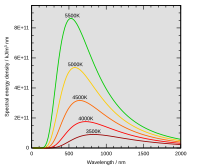
Photo from wikipedia
Abstract In this work, the photostability of gold nanoparticles (AuNPs) with different functional molecular coatings was investigated. Gold/water nanofluids were prepared using citrate (CIT) reduction, then coated with polyethylene glycol… Click to show full abstract
Abstract In this work, the photostability of gold nanoparticles (AuNPs) with different functional molecular coatings was investigated. Gold/water nanofluids were prepared using citrate (CIT) reduction, then coated with polyethylene glycol (PEG), polyvinylpyrrolidone (PVP), or bovine serum albumin (BSA) by physical/chemical ligand adsorption. All nanofluids retained their monodispersity and extinction efficiency after ambient storage for three years. These long-term aged nanofluids were then subjected to accelerated indoor tests that mimic the prolonged and cyclic exposure to both full-spectrum and specific-band radiation. This included continuous exposure to broadband solar radiation at various intensities and focused near-ultraviolet (NUV) radiation for different durations, as well as cyclic exposure (in irradiation/darkening periods) to both solar and NUV radiation. Assessment of post-test stability has been realized using complementary characterization techniques. Results showed that stability was variable to the coating type, radiation exposure mode, and radiation spectrum. Subtle physicochemical transitions in the polymeric coatings, even in the absence of ligand desorption and particle clustering, were shown to alter the optical properties and wettability of the nanofluids. While the gold cores remained intact, some photoinduced instabilities occurred in the adsorbed polymeric coatings, including chain scission of PEG, conformational collapse of PVP, and partial denaturation of BSA. Largely attributed to the strong polymer-Au interactions and high surface grafting densities, and despite their coating transformations, AuNPs maintained a high level of photostability. This work marks important progress towards realizing photothermally superior, yet colloidally stable, solar nanofluids compatible with a wide range of direct-absorption photothermal applications in the water and energy sectors.
Journal Title: Solar Energy Materials and Solar Cells
Year Published: 2021
Link to full text (if available)
Share on Social Media: Sign Up to like & get
recommendations!